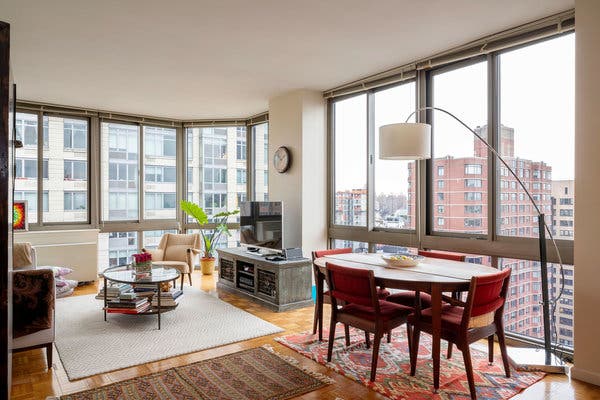Aasif Mandvi is here to tell you that experience richly deserves its reputation as the best teacher. Mr. Mandvi’s own particular experiences as a renter in New York taught him lessons enough to fill a column.
For example, give a wide berth to apartments where the occupant-bathroom ratio exceeds three to one. Being the sole male among half a dozen female South American graduate students in a railroad flat is not nearly as good as it sounds.
When you’re set to take over the lease of a basement apartment, and the previous tenant alerts you to the annual infestation of June bugs, do not, not, not brush off the warning and say “Oh, June is months off.”
Is this the time to mention that the basement apartment flooded, that the carpeting got washed away, leaving bare concrete, that cats (yes, cats) fell from the ceiling and that, nonetheless, Mr. Mandvi, an alum of “The Daily Show” and the TV Land series “Younger,” remained in residence for two years.
One could argue that he is a slow learner. But there is probably a nicer way of putting it.
“I’m a late bloomer,” said Mr. Mandvi, 53, a star of the new CBS supernatural drama “Evil” and the host of a new podcast, “Lost at the Smithsonian with Aasif Mandvi.” Two years ago, he married Shaifali Puri, a former executive for nonprofits, and the couple moved into a nicely laid-out corner unit with two bedrooms and floor-to-ceiling windows on the 26th floor of a rental building in Chelsea.

“This is an adult apartment,” Mr. Mandvi said.
If the space is a bit generic, the view is anything but. He and Ms. Puri can see the Hudson River, they can see clear over to New Jersey and all the way down to One World Trade Center.
“When I first walked in,” Mr. Mandvi said, “it felt like the quintessential New York apartment, in the sense that it was the New York apartment you see in movies — where people are drinking martinis and where Gordon Gekko stands and looks out over the skyline.”
Aasif Mandvi, 53
Occupation: Actor
Good housekeeping: “This is the first apartment I’ve lived in that my family doesn’t walk in and go, ‘We need to fumigate, we need to build bookshelves.’”
Outfitting the apartment required delicate negotiations. Mr. Mandvi had his premarital furniture; Ms. Puri had hers. In almost all instances, Ms. Puri’s furniture won.
Those are her rugs; her glass-topped coffee table; her bookshelves; her off-white sofa (because, as she explained, she wasn’t going to spend her life sitting on the brown leather sofa the groom was offering); her midcentury-modern chair.
Initially appalled, Mr. Mandvi has now co-opted it: “It’s my Archie Bunker chair,” he said.
Ms. Puri smilingly explained the terms of engagement: “We each agreed to give up some things.”
“What did you give up?” her husband demanded.
“Some lamps.”
“Some lamps?”
“One lamp,” she amended.
Mr. Mandvi did prevail in the matter of his armoire, a hulking, dark wood piece that he bought in an East Village antiques shop, and that he is absolutely certain he knew in a previous life. (The wood coffee table that he bought at the same store has been tucked discreetly away — that is to say, hidden — in the office/guest bedroom.)
“There’s a word for falling in love with an inanimate object,” he said. “I have no idea if it’s a real antique or a total knockoff, but I love it. I love old broken-down things, and there’s a huge crack in it.”
Initially resistant, his wife has softened her stance. “The armoire has kind of grown on me,” said Ms. Puri, who made the very useful suggestion that it be used as a bar.
“Aasif and I are very different,” she added. “Still, the apartment has come together in a messy but harmonious way.”
For what it’s worth, the two were in complete sync about the desirability of sun-yellow frames to hold the illustrations clipped from a book of pictures by Mumbai artists. The poster-size blowup of a photo they took along the Pacific Coast Highway right after they got engaged is exactly right hanging in the foyer, they agree. It’s the first thing that visitors should see. About that, they’re in accord as well. And they both speak with tenderness of the quilted throw pillows that were made from small squares of the saris, nightgowns and dupattas that belonged to Mr. Mandvi’s mother, now deceased.
“This is one of the saris I remember,” Mr. Mandvi said, pointing to a piece of pale purple fabric. “All these have memories for me. You would think it would be morbid, but it’s actually kind of cool.”
Two months after signing a lease, the couple looked out the windows in the living room and saw two buildings starting to go up. And up.
“You know how you have those notches you make on a wall when your child is growing taller, and you keep marking a different height?” Mr. Mandvi said. “That’s how we were with the buildings: ‘Oh, maybe that’s the top. Oh, that’s the top for sure.’ And they kept getting higher and higher. Now they’re taller than our building.”
He and Ms. Puri are making their peace with it. After all, at ground level the neighborhood has plenty to offer, and they want to take full advantage. Barely a day goes by that they aren’t at Fairway or Trader Joe’s. The High Line is just a few blocks away. They’ve been there, uh, twice.
“It’s funny, as you get older, the things you care about,” Mr. Mandvi said. “You think you’re sophisticated, and then you think, ‘I just want to be really close to Whole Foods.’”
For weekly email updates on residential real estate news, sign up here. Follow us on Twitter: @nytrealestate.







